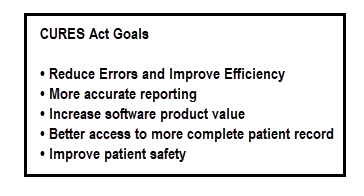
Healthcare felt like it’s been on the verge of transforming for years, if not decades. Then, in a matter of months, the pandemic broke down many long-standing barriers and accelerated digital health care systems at a pace few could have imagined. As a result, the future of healthcare is not just convenient and virtual-first but designed around a “Quadruple Aim of Healthcare.”
This interdependent system has four goals:
- Improve the patient’s healthcare experience
- Improve patient health
- Reduce costs
- Maximize the well-being of the care team
A key driver of this movement is adopting information-sharing solutions intended to efficiently exchange patients’ health information between doctors, dentists, labs, and other medical facilities. This, in turn, leads to reduced medical errors and improves overall care. One key driver in this effort is the “interoperability of data” through the CURES Act 2021. Initially passed in 2016, the bipartisan bill will be fully implemented in 2022.
“Dentists and dental practices should recognize this as an opportunity to coordinate care, reduce errors, improve care quality and increase patient satisfaction”, said Dr. Gregory Zeller, past chair of the ADA Standards Committee on Dental Informatics and current chair of the subcommittee on clinical informatics, in an interview late last year in the ADA News. “Other players, including dental technology vendors, payers and regulators, interested in the electronic exchange of data necessary to support value-based payment models are also interested in development of these standards, which will eventually shape what payers, providers and consumers are able to exchange seamlessly”
Source: ADA leads charge to foster interoperability
What is the Cures Act Final Rule, and why is it important?

The Cures Act Final Rule implements interoperability requirements for dental and medical providers to empower patients with their health records. For the American public, the final rule promotes innovation in the health care technology ecosystem to deliver better information, more conveniently, to patients and clinicians. It also promotes transparency, using modern computers, smartphones, and software to provide opportunities for the American public to regain visibility in health care services, quality, and costs.
(See: ONC’s Cures Act Final Rule)
One of the act’s key provisions prohibits information blocking and defines the parameters considered reasonable. It also defines necessary activities that would not constitute information blocking.
(See: What it means for me)
What Dentrix Enterprise Already Does and Doesn’t Do
Dentrix Enterprise does NOT engage in blocking access to patient information, as it provides appropriate access, exchange, and use of Electronic Healthcare Information (EHI). It also provides HL7 interfaces to other systems, CCDA patient summary data exports, a patient portal service, and access to health information exchanges. In addition, for more customized needs, it does provide access to the Dentrix Enterprise SQL database and a web API. Therefore, Dentrix Enterprise does meet the Cures Act requirements and has met the April 5, 2021 assurance deadline.
(For technical details about Dentrix Enterprise API access, see: Dentrix Enterprise API Overview)
What Changes does Dentrix Enterprise Plan to Make to be Fully Compliant by the 2022 deadline?
The Dentrix Enterprise team is in the planning or development stages for all Cures Act Conditions of Certification and any accompanying maintenance of applicable Promoting Interoperability Program (Meaningful Use) 2015 Edition certification requirements. We want to keep you updated on our progress and next steps in this process, as there are both new and revised criteria. See the Dentrix Enterprise Cures Act webpage for important details on all planned updates and implementation dates.





